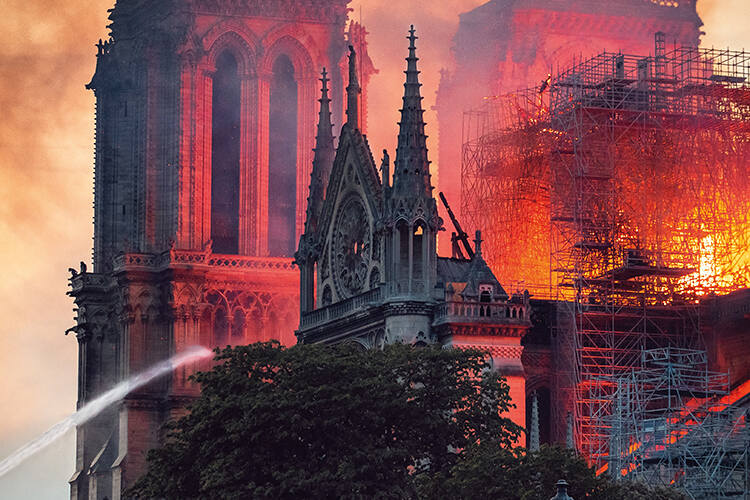
Tim Clark meets the band of itinerant craftsmen who, using ancient skills, helped to rebuild Paris’s landmark cathedral as it was 800 years ago
On 15 April 2019, a fire ripped through the Notre-Dame de Paris, engulfing the entire original oak roof. Known as ‘la forêt’ or ‘the forest’, the oak timbers had stood for 800 years prior to their destruction. From that point on, the race was on to work out how it could be rebuilt and who could do the work.
Now as members as the public await eagerly to see the restored appearance of the iconic landmark – opening on Sunday 7 December – it’s more important than ever to recognise the immense body of work required to achieve its rebuilding.
In the initial days and weeks after the fire, many doubted whether the skills still existed to rebuild Notre-Dame’s ancient timber roof – and if it weren’t for a body known as Charpentiers sans Frontières (Carpenters without Borders) and their founder, François Calame, they more than likely would have been proved right. Over the years, Calame had met up with a number of highly skilled carpenters who were working using traditional skills. In 1992, he decided to form an association to keep these skills alive and to share their knowledge, particularly in the centuries-old craft of oak framing.
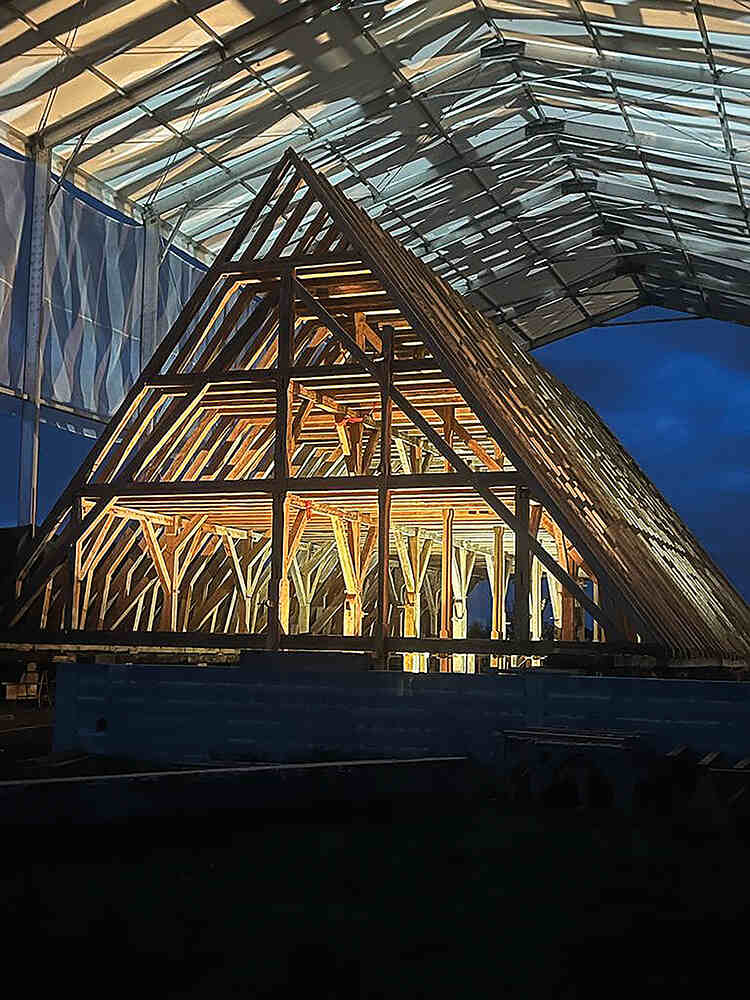
Rémi Fromont, chief architect of French historic monuments, who carried out studies on Notre-Dame in 2014, was crucial when it came to convincing authorities that the cathedral should and could be rebuilt according to the original designs. He persuaded the Rebâtir Notre-Dame de Paris, the authority in charge of the restoration, to use two traditional woodworking firms: Atelier’s Perrault for the rebuilding of the wooden choir section and Atelier’s Desmonts for the construction of the vast frames for the new roof of the cathedral’s nave. The call then went out for experienced craftsmen.
A British recruit
One of the band of 25 itinerant carpenters who answered that call was former Royal Marines commando Mike Dennis. Dennis saw action in both Iraq and Afghanistan before becoming an English teacher in China and working as a fitness instructor on cruise ships. On a whim, he decided to undertake a traditional carpentry course in the Brecon Beacons and was hooked.
‘I was looking for a career that would allow me to travel,’ he says. ‘A pilot? Well, that would set me back £50,000 before I even started. Doctor? Well, I don’t really like people, or at least operating on them. But carpentry? How hard can that be?’
A stint in Canada saw him help restore a trestle bridge on Vancouver Island, dangling from ropes 40 metres up, chainsaw in hand. Notre-Dame is his biggest project to date. ‘Initially, I was slightly hesitant to get involved in Notre-Dame,’ he says. ‘But looking at the project from a global perspective, it was an opportunity to show the world that the skills to rebuild it are still there. We are losing vernacular architecture, especially in rural France. We can show people that these techniques, which were the pinnacle of a craft, were used in people’s everyday houses. This isn’t just for projects such as this – it can be applied elsewhere. Anyone can do this, with time and effort.’
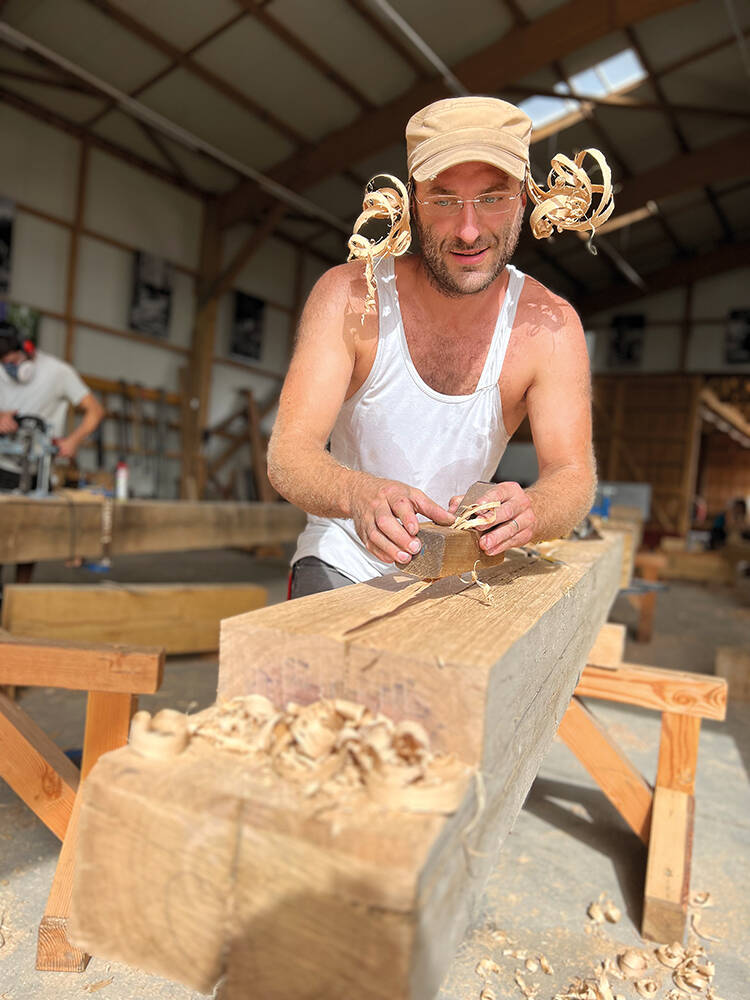
Normandy workshop
The Normandy team were tasked with building 11 principal trusses more than 14 metres wide and ten metres high, along with 45 secondary trusses of the same size for the nave of Notre-Dame. In charge of the Normandy workshop is 25-year-old Loïc Desmonts. ‘I wanted to be a farmer or, like all the kids, fly a fighter plane,’ he tells me. ‘Then I met Charpentiers sans Frontières when a group of them came to Normandy a decade ago.
‘I remember the sensations I had smelling the fresh oak, the sounds of the axe and the timber framers, people talking different languages and people laughing so loudly. I told my father I want to do timber framing – to work with my hands and with my brain.’
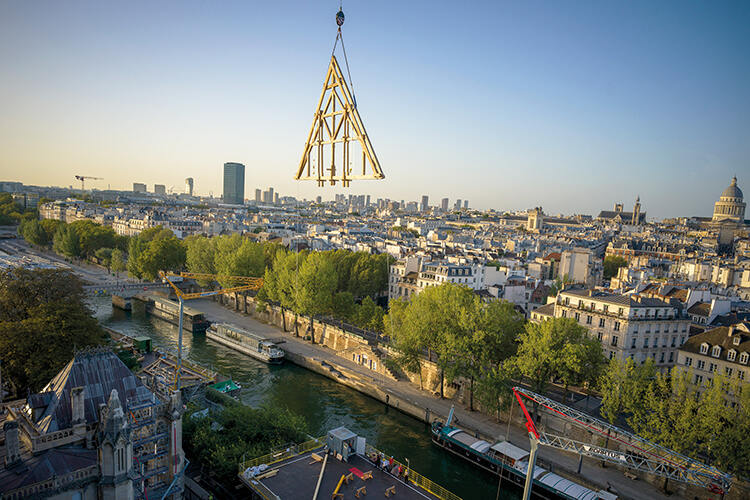
For Desmonts, it wasn’t simply that he wanted to land a major project for his business. He wanted to understand how such an impressive building was made 800 years ago. ‘There is not just design history, there is human history in Notre-Dame,’ he says. ‘For us, the cathedral was built at a time when the mortise and tenon [parts of a joint that connects two pieces of wood] were just beginning to be used in France, so it’s interesting to see how they changed the way they were doing the trusses.
‘When you are here [in the workshop] you don’t realise it, but when you go on site at the cathedral, it is crazy beautiful,’ he continues. ‘It makes you think the intelligence we have now is not the same as what they had. They were as smart as us, but in a different way.’
Finding the right trees
More than 1,300 trees were needed for the rebuilding, with foresters working from a call sheet for the different trusses to find the trees that had the right diameters and lengths for the project. The demands of Notre-Dame were exact. The tree had to have little sapwood, which is weaker, and no knots. There’s no way of knowing which tree has excess sapwood until it’s hewed. As carpenter Solène Savaëte, who accompanied the foresters on their search, says: ‘If you drill a hole in the tree, you buy it.’
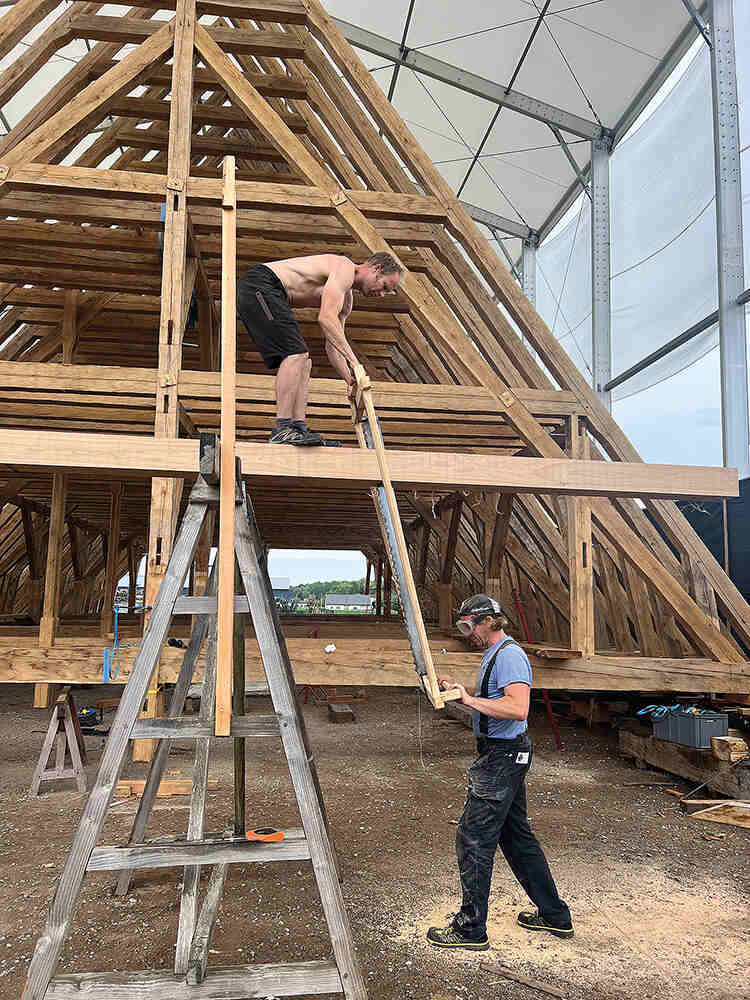
Around 80 forests in the Rouen region were scoured for oaks of the right quality for the nave. ‘We didn’t go in and make a big hole in the forest,’ Desmonts adds. ‘A lot of people were thinking that we would destroy the forest [when felling the trees], but we didn’t want to come into the forest like a predator. It is more like collecting mushrooms.’
In the workshop
From the outside, Ateliers Desmonts isn’t dissimilar to an average industrial warehouse. However, as you head into the workshop, you’re confronted by what looks like a medieval armoury of axes. On the opposite wall are rows of chainsaws. In between sit trolleys of chisels, hammers and, somewhat incongruously, a stack of iPads. The oak timbers are turned into beams by hand hewing the wood with axes in the same way as medieval craftsmen would have worked.
The restoration work on the cathedral is one of the biggest hand-hewn framing projects in more than a century. ‘Most of us haven’t had the chance to hew every day for one, two or three months at a time; it’s a rare thing,’ Dennis says as he wields his own axe to trim the edges off a chapeau du console – a two-metre-long timber that sits underneath the main part of the frame to help distribute weight.
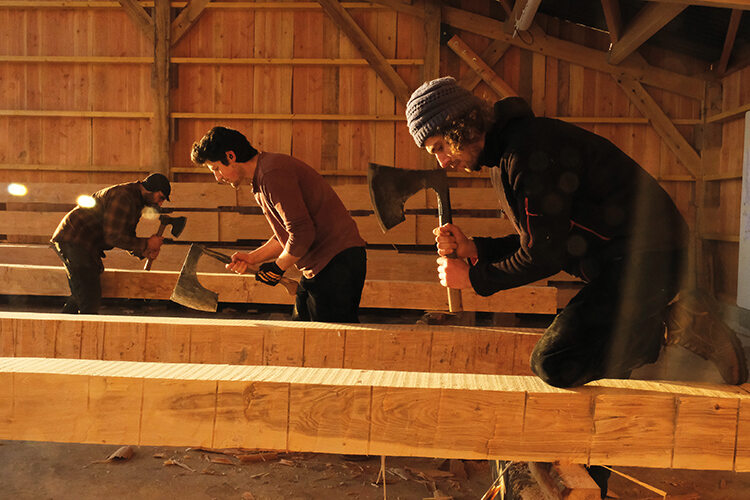
The ends of the original chapeau du console were individually carved. No-one is sure why; it may have been a way for each carpenter to express themselves.‘You’re lacking a lot of information,’ Dennis says as he draws lines using a pencil and compass to work out the proportions of a carving. ‘You always want more information than you’ve got. Luckily, we have a few photographs of the original roof timbers.’ Dennis takes hold of an axe to start shaping a replica of a 13th-century carving. Shavings fall to the floor as the axe bears down on the oak, which is then hand-planed smooth.
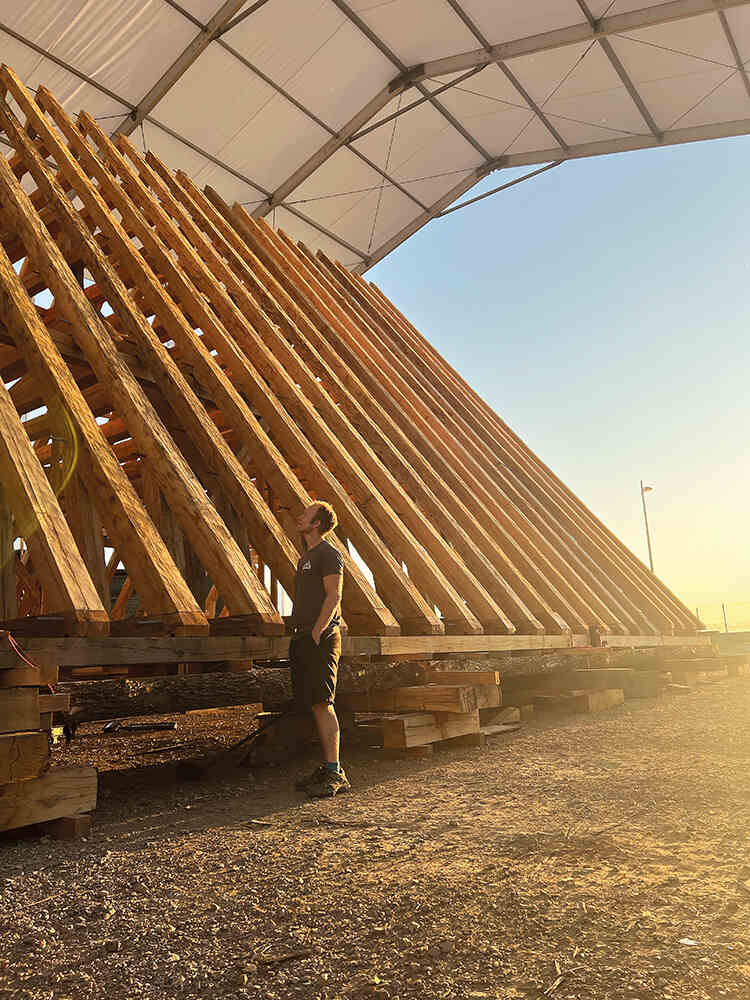
‘You start to get a feel for which axe suits which individual,’ he says as he carves the wood. ‘There is the weight, where it is distributed, the curvature of the blade, the bevel. For some people, an axe will work beautifully; for others, it won’t.’ A good axe can easily set a carpenter back €1,000.
For some unknown reason, the first seven primary trusses on Notre-Dame’s original nave roof were all built to slightly different designs. It’s thought that the medieval carpenters were, to a certain extent, learning on the job. As they interpret the previous designs, the Gothic craftsmen’s modern contemporaries are left to draw their own conclusions as to why each frame is different. The team showed me truss number two, a particularly complicated frame.
‘I think this truss was the first one they built,’ says French carpenter Mathieu Larigot as he explains his thesis for why this particular truss is so different to the others. ‘I think when they came to build Notre-Dame they started here, and they realised they needed these extra beams, and so they put them in around the frame.’

Desmonts’ thesis is more practical. ‘Truss number two is the only one like this, and I know why,’ he says. ‘It is a bit shit to make. The medieval carpenters kept changing the process up to frame number seven. Then they said, “This is the easiest to put together,” and stuck at it.’
The debate acts as a microcosm of the wider argument over how Notre-Dame was originally built. The original carpentry mistakes from the 13th century act like scars, divulging vital information to the modern team. The entire project is a form of experimental archaeology.
The wandering craftsmen
The Normandy site has drawn carpenters from the USA, France, the UK, Estonia and Germany.
‘It’s definitely a lifestyle, this type of carpentry,’ Dennis says. ‘It probably goes back to the long tradition of the journeyman carpenter. It was traditional to go on a journey after an apprenticeship. Some countries still do this. There is probably in us that passion of wandering, doing new and interesting things. Because it is a craft and you can never know everything; you’re always sharing.’
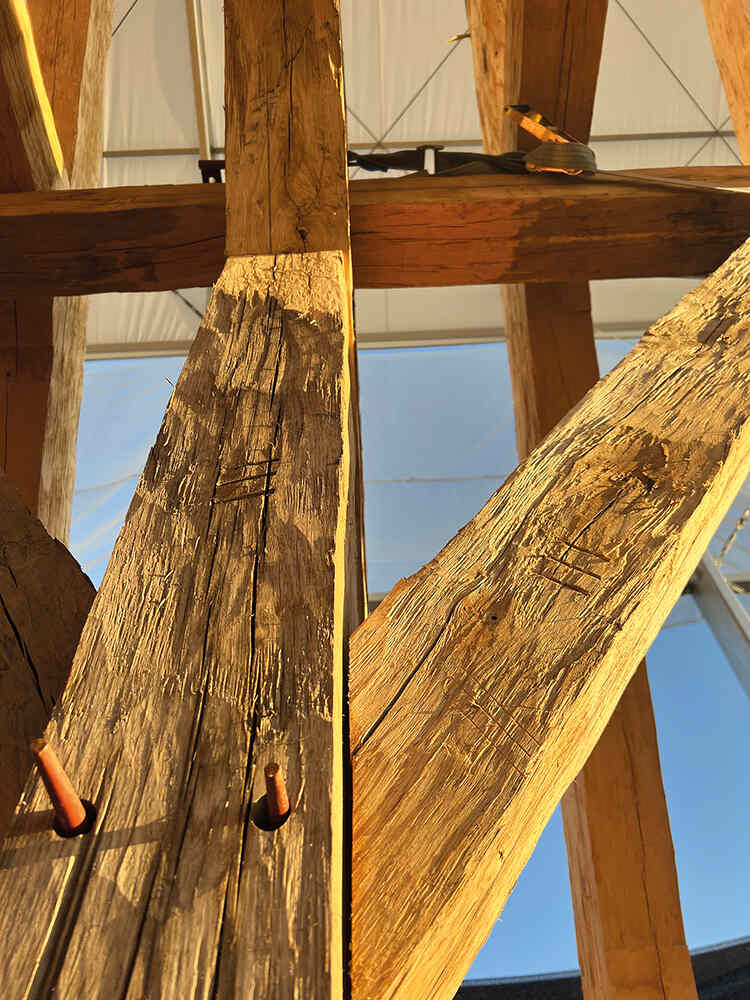
Andres Uus, a log-building lecturer in the Estonian University of Life Sciences, had come to France for what he called a working holiday for three weeks. I join Dennis, Uus and Desmonts for two nights at Le Petit Moulin, a disused water mill that acts as home for many of the crew. I arrive as Carlos Barbero, who had worked on the project for two months, is preparing his leaving celebration: pizza and wine.
He asks Dennis when he’ll see him again: ‘November? In French Guyana?’ ‘Maybe,’ is the noncommittal reply. The carpenters have a semi-nomadic lifestyle, moving from project to project, where they meet each other, share experiences and find out about the next build.
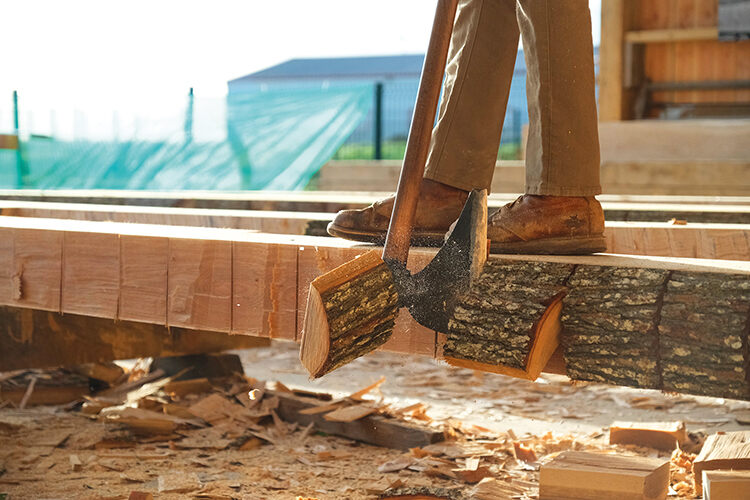
Evenings are early, most retiring to bed just after 9pm and waking well before sunrise. Access to my bed in the attic, which includes old mill machinery, a simple mattress and a lamp, is via a narrow wooden ladder.
In the workshop, the huge completed roof frames await the difficult journey by road to the heart of Paris. Meanwhile, the carpenters work on the next pieces of the jigsaw. Occasionally, a worker comes over to contemplate the finished frames, or eat their sandwiches beneath them. Someone has slung a hammock high up in the timbers to provide a spot for an afternoon nap. In the afternoon heat, the whole workshop creaks as the wood warms up. It sounds as if some stray livestock has climbed onto the roof and can’t get down.
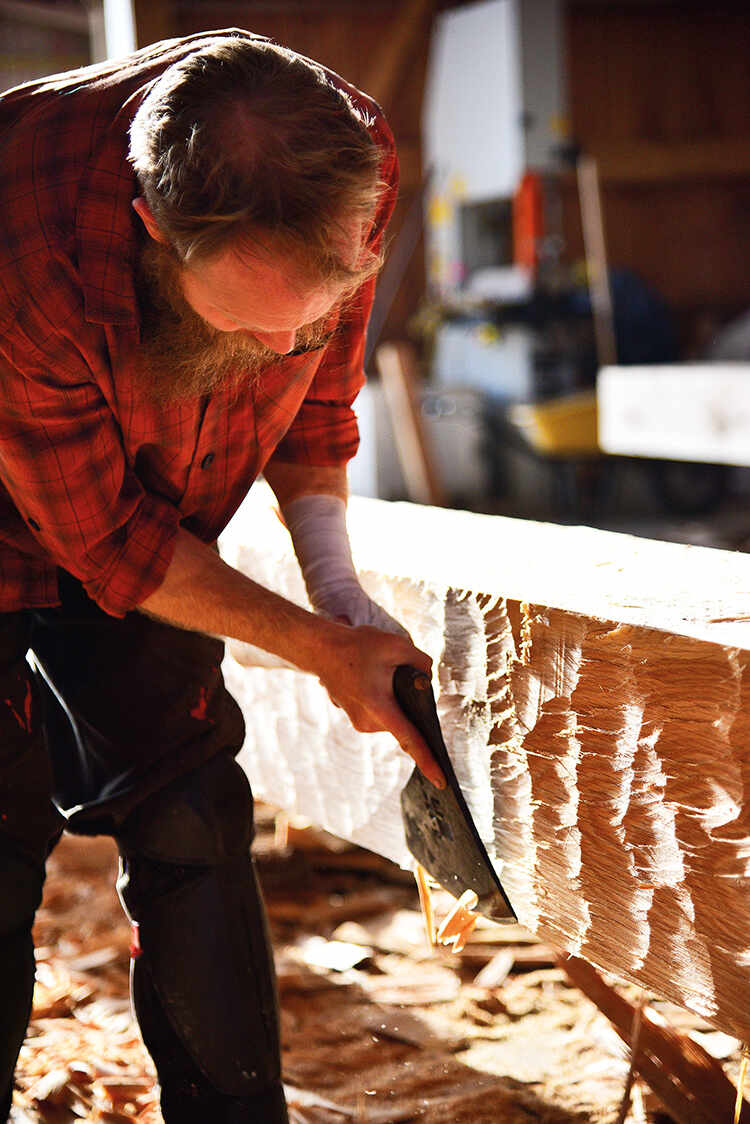
Heading home
The race to get the cathedral ready was certainly a long, arduous – but crucially rewarding role for all those involved. After more than a year of intense work, the majority of the framing was complete. Dennis headed home. Two weeks after my visit, he’s named by King Charles in a state speech at Versailles as a living example of the Entente Cordiale for his work on Notre-Dame.
Asked what awaits him in the coming months, he ponders his future. It could be volunteering for a project in Suffolk, where they’re building a replica of the Sutton Hoo burial ship or applying for a PhD based on his Notre-Dame experience. Uus is off back to Estonia. On Monday, he’ll be teaching at a college in his small town of 15,000.
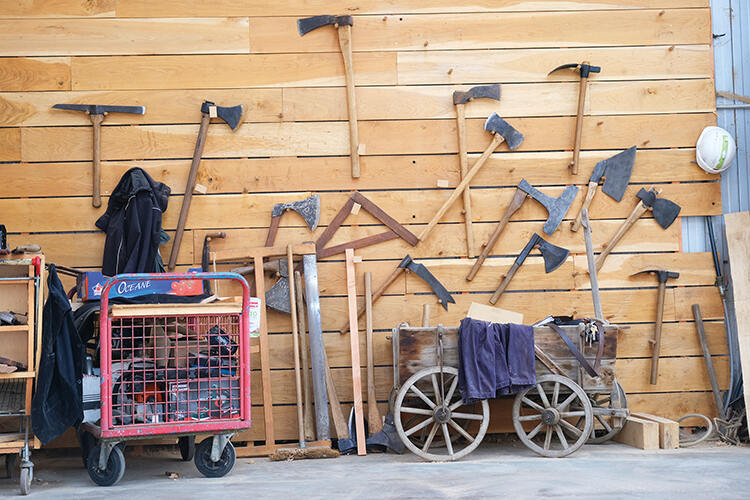
The carpenters are unfazed that their craftsmanship will be hidden away to the public upon the Notre Dame’s opening. They know it’s there and that they built it. Hopefully, in 800 years, it will still be there. Dennis has one final thought. He says it was great that they were paid as much as Ateliers Desmonds and the restoration project could afford, but adds: ‘The truth is, we would have come and built this for free.’




